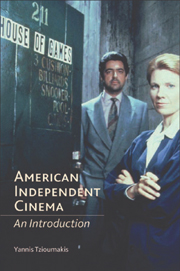Book contents
- Frontmatter
- Contents
- Analytical Table of Contents
- List of Tables
- List of Case Studies
- List of Figures
- Acknowledgements
- Dedication
- Introduction: Problems of Definition and the Discourse of American Independent Cinema
- Part I American Independent Cinema in the Studio Years (mid-1920s–late 1940s)
- Part II The Transitional Years (late 1940s–late 1960s)
- Part III Contemporary American Independent Cinema (late 1960s–present)
- 5 The New Hollywood and the Independent Hollywood
- 6 American Independent Cinema in the Age of the Conglomerates
- 7 Mini-majors and Major Independents
- 8 The Institutionalisation of American Independent Cinema
- Epilogue: From Independent to ‘Specialty’ Cinema
- Bibliography
- Index
8 - The Institutionalisation of American Independent Cinema
from Part III - Contemporary American Independent Cinema (late 1960s–present)
- Frontmatter
- Contents
- Analytical Table of Contents
- List of Tables
- List of Case Studies
- List of Figures
- Acknowledgements
- Dedication
- Introduction: Problems of Definition and the Discourse of American Independent Cinema
- Part I American Independent Cinema in the Studio Years (mid-1920s–late 1940s)
- Part II The Transitional Years (late 1940s–late 1960s)
- Part III Contemporary American Independent Cinema (late 1960s–present)
- 5 The New Hollywood and the Independent Hollywood
- 6 American Independent Cinema in the Age of the Conglomerates
- 7 Mini-majors and Major Independents
- 8 The Institutionalisation of American Independent Cinema
- Epilogue: From Independent to ‘Specialty’ Cinema
- Bibliography
- Index
Summary
INTRODUCTION
Orion's fall and eventual bankruptcy demonstrated to the other independents that economic survival depended heavily on ‘cooperation’ and ‘symbiosis’ with the conglomerated majors, the only companies with the power to release a product in every possible exhibition outlet and therefore maximise its profitability. Furthermore, the conglomerates also had the financial muscle to absorb any losses at a time of box office dry spells like the one Orion experienced in the late 1980s/early 1990s. The symbiosis between majors and independents has primarily taken two forms. First, it has taken the form of corporate takeovers, whereby independent companies were bought out by the majors but were left to operate as semi-autonomous units (Miramax, New Line and a number of the so-called ‘neo-indies’ such as Morgan Creek, Castle Rock, and so on). Second, it has taken the form of distribution contracts, whereby independent production companies became satellite companies for major distributors (much like Orion with Warner [1978–82]). Whatever the form, commercial independent film production and distribution have become increasingly ‘dependent’ on the entertainment conglomerates, to the extent that the label ‘independent’ has become even more contentious than it was in the previous decades while the discourse on independent cinema has expanded to such an extent that the vast majority of films produced in the US can be considered independent.
- Type
- Chapter
- Information
- American Independent CinemaAn Introduction, pp. 246 - 280Publisher: Edinburgh University PressPrint publication year: 2006



